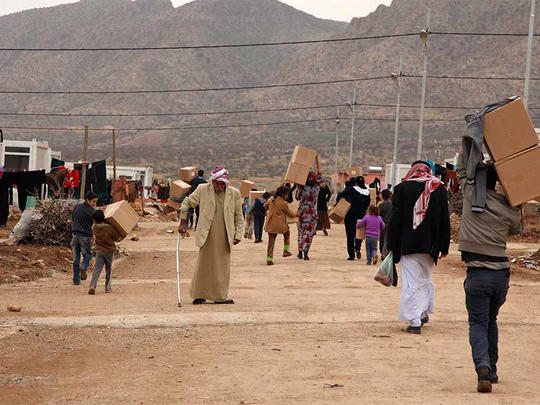
Arbil: Kurdish forces backed by foreign jets pressed an ambitious operation against Daesh in northern Iraq on Thursday, taking on the militants in the heart of their ‘caliphate’.
After mass bombing by aircraft of the US-led coalition paved the way for ground troops Wednesday, Iraq’s Kurdish Peshmerga retook several villages and closed in on the Sinjar area.
It was the capture of Sinjar by Daesh in early August, and the risk of genocide against its largely Yazidi minority population, that was one of the reasons US President Barack Obama put forward for launching the air war against the militants.
Fresh strikes were conducted on Thursday north of Tal Afar, one of the first areas to fall to Daesh fighters in early June, Anwar Brahim, a senior officer with the Kurds’ Asayesh intelligence services, said.
“At around 7am (0400 GMT), there were coalition strikes on Nahyat Al Ayadhiya,” Brahim said. “A large deployment of Peshmerga is ready to close in on Sinjar.”
Kurdish forces used heavy artillery to pound Daesh positions in the area, but officials said the fighting was less intense than on Wednesday.
The US military command supervising the coalition air campaign said Wednesday that 61 air strikes had been carried out in Iraq since Monday.
That was some of the heaviest bombardment since the militant onslaught on the Sinjar area and towards Iraq’s autonomous Kurdish region prompted the first US air raids four months ago.
The US military said “45 strikes were conducted in support of the Peshmerga and Iraqi security forces operating in the region”.
Footage released by the Kurdish government showed the charred carcasses of Daesh vehicles destroyed by air strikes and the militants’ black flag still flying over abandoned positions.
The Peshmerga said they recaptured eight villages and killed around 80 Daesh fighters in the initial phase of the two-pronged offensive, launched from Rabia on the Syria border and Zumar on the shores of Mosul Dam lake.
Brahim, who is the Kurdish intelligence chief for the Zumar area, said six Kurdish troops were killed and 31 wounded in the first day of fighting.
Sinjar, between the Syria border and Iraq’s Daesh-held second city Mosul, is one of the main goals of the offensive.
The operation aims to disrupt Daesh supply lines and further isolate Mosul around which the militants have been building trenches in recent weeks.
Daesh has also cut the mobile phone network in the city and imposed tougher restrictions on the population’s movements, sparking accusations they are seeking to use civilians as human shields in the event of an attack.
The militants have suffered a string of recent setbacks in Iraq, but the front lines have been more static in Syria.
The 60-nation US-led coalition against Daesh, which also carried out five air strikes in Syria this week, is not cooperating with the Syrian regime.
The administrations in Baghdad and in autonomous Iraqi Kurdistan, however, have received strong support from Western governments, in the form of weapons, aid and thousands of military advisers.
Kurdish leaders said one of the objectives of Wednesday’s offensive was to “break the siege on Mount Sinjar”, which was the scene in August of one of the conflict’s most dramatic episodes.
Daesh killed hundreds of residents, abducted and enslaved hundreds of Yazidi women and girls, and forced tens of thousands to seek refuge on Mount Sinjar.
Civilians remained besieged there for days in the searing summer heat with little to eat or drink before a breach in the siege allowed them to flee.
Yazidi fighting units that were formed in the wake of the August attack have struggled to control land in the Sinjar area and retreated to the mountain in September.
A few thousand people are still atop Mount Sinjar in what Yazidi leaders have called a “second siege”.
Some are residents of the mountain but most are fighters, from various regional Kurdish groups or recently-formed Yazidi militias.












